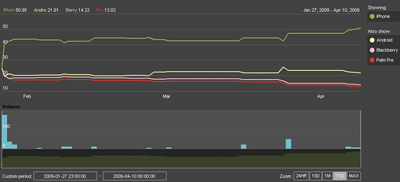©2009 Bryan Alexander. The text of this article is licensed under the Creative Commons Attribution 3.0 License (http://creativecommons.org/licenses/by/3.0/).
EDUCAUSE Review, vol. 44, no. 3 (May/June 2009)
One example of a prediction market with direct application to higher education was organized by the National Institute for Technology and Liberal Education (NITLE) in early 2008. The market is based on two major themes within the NITLE research portfolio: (1) gaming and its uses for learning, a topic NITLE had been exploring for several years and through various venues; and (2) emerging technologies and their implications for academe. Experimenting with a prediction market let NITLE combine these two areas productively.
After researching the state-of-the-art in prediction markets, NITLE assembled a group of advisors from different campuses and in different professional positions. It also selected a markets vendor, Inklings, to host a prototype game, one containing a series of propositions covering multiple areas within the larger category of technology and higher education. Inklings hosts prediction markets as a web service, accessible through a browser and published with a Web 2.0–style architecture. These markets are based on a series of propositions concerning future events. The advisors helped NITLE generate those proposition topics and then went on to play the resulting market for several months. Some NITLE staff joined in the trading as well. In summer 2008, the advisors met with NITLE staff via videoconference and e-mail, sharing their experiences and reflections about how the markets had worked for them. The advisors also offered suggestions for the project's next phase.
That phase began in the fall of 2008. After some redesign, NITLE launched a free beta version of the NITLE Prediction Markets (http://markets.nitle.org/) in September. This version, aimed at a broader audience, was open to any visitor who provided an e-mail address. New traders created accounts immediately, and more players have been joining ever since. Currently, approximately 220 traders explore about 12 propositions. Several dozen more propositions can be read and their trading record examined, but these can no longer be played, since their time period has expired. Taken together, all of these propositions, which appear about every two weeks, cover a wide range of topics, from the size of the Second Life user base (http://markets.nitle.org/markets/19285) to the extent of open-source course management systems (http://markets.nitle.org/markets/10692).
For example, a recently concluded proposition concerned smartphone platforms and their presence on campuses. It suggested four possible phones as candidates and asked which would be the leader in mid-2009: "Which smartphone or smartphone platform will be the most popular for campus-supported teaching and learning projects by May 2009: iPhone, Android, Blackberry, Palm Pre?" Traders bought and sold shares over time, based on their assessment of each platform's likely dominance in higher education (http://markets.nitle.org/markets/17594). A snapshot of the trading shows how quickly one smartphone rose above the others:

Figure 1: This reflects a form of consensus, mediated by the market mechanism. The iPhone's lead represents a collective guess about the future, visible to players and casual web browsers alike. Click image to see a larger version.
From a "push" perspective, the NITLE Prediction Markets are connected to several other Internet venues. NITLE often posts news of trades, the start of new propositions, and the end of old propositions on its blog, Liberal Education Today (http://let.blog.nitle.org), as well as on several e-mail lists, as appropriate. NITLE researchers and some traders post to Twitter about developments. And NITLE promulgates the markets through scholarly and professional events, seeking feedback and more participation. From a "pull" view, players sometimes head to the markets after learning about them from a news story. Others play the markets in order to share their thoughts and assessments following a personal experience with a technology or technological practice. Some players also subscribe to the RSS feeds for the markets.
After a year of exploration, NITLE has derived some lessons about gaming and emergence. First, players tend to prefer relatively short-lived propositions. Terms of several months or even weeks attract more trading and interaction that terms lasting for one year or more.
Second, e-mail remains a powerful communication medium, even for a Web 2.0 project such as this one. Consistently, spikes in game activity occur after e-mail updates.
Third, market trading is autonomous. Although an administrator can shape a proposition with a specific outcome in mind, traders often drive values in very different directions. This can be seen as a virtue in several different ways, not the least of which is broadening discussion and increasing variety.
Finally, games can attract academics to serious play. Intense conversations, passionate trading, and competitive relationships have all emerged in the NITLE Prediction Markets, as players have attempted to better understand the near future.
Clearly, the prediction market is "a tool to think with." Those of us at NITLE have learned from traders in a distributed, fluid way. Their collective thinking offers aggregate opinion beyond the single perspective of any participant. We (NITLE staff) do not control play. Indeed, as traders, we are quite capable of being out-traded—out-thought, really—by other players. Individually, as each proposition unfolds in play over time, it provides a glimpse of likely outcomes. As a whole, the markets offer unusual and sometimes useful input into emerging trends, complementing other methods for apprehending the future.
